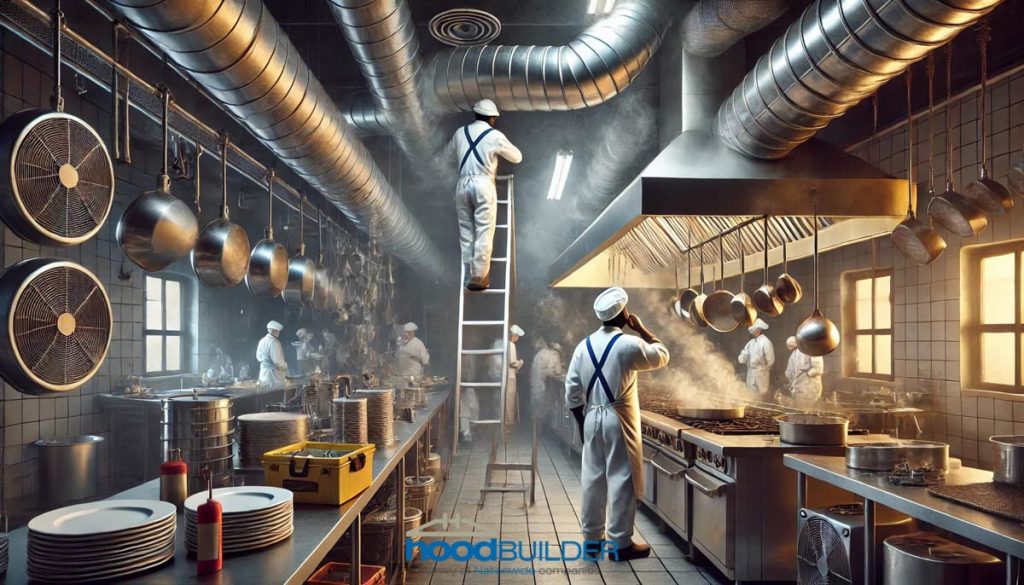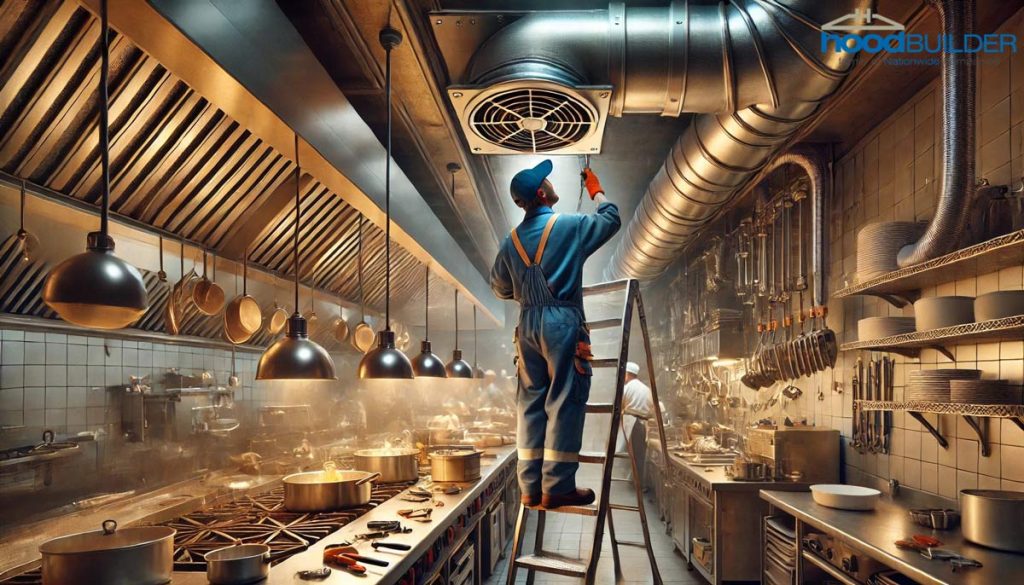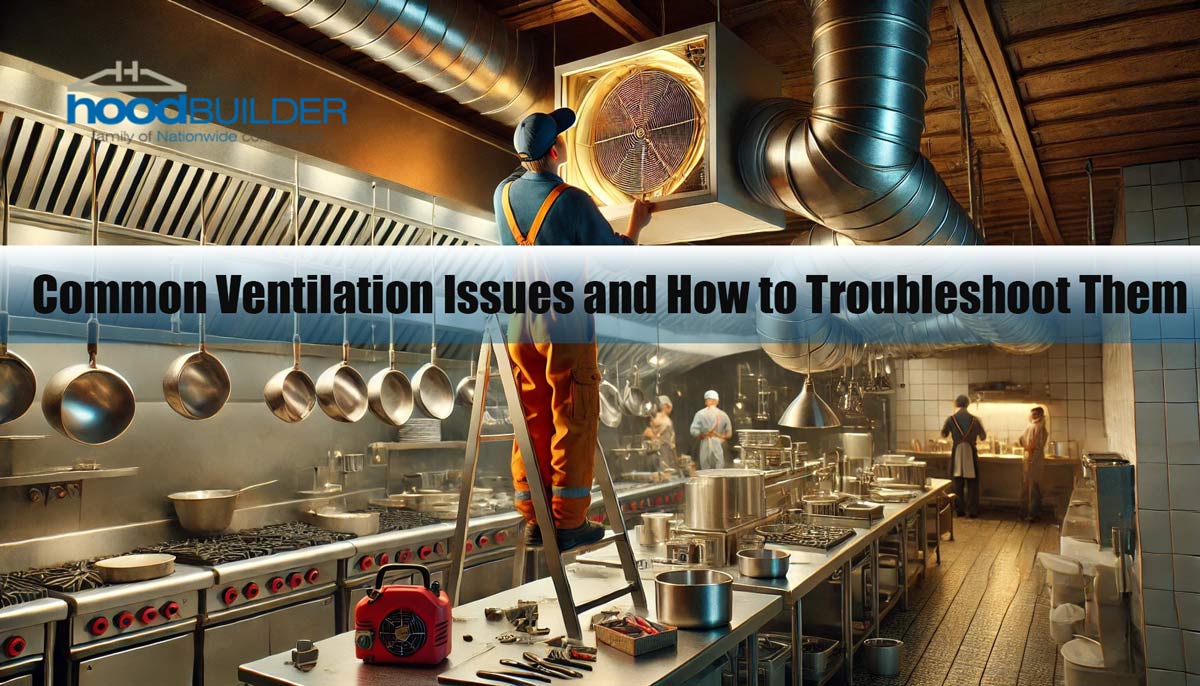Ventilation issues are a big challenge for maintaining air quality, ensuring safety, and maximizing overall efficiency in the busy environment of a commercial kitchen.
Many kitchens face common ventilation issues that can lead to uncomfortable working conditions, increased fire hazards, and even regulatory violations.
Challenges such as inadequate airflow, lingering odors, and excessive heat and humidity can disorganize the kitchen and impact the health of your staff and customers.
In this article, we will explore the most common commercial kitchen ventilation issues and provide practical troubleshooting tips to help you and your staff create a safer and more comfortable cooking environment.
Looking for a safe and efficient kitchen free of any ventilation issues? Don’t miss the time. Hood Builder is proudly at your service.
Understanding the Importance of Proper Ventilation
First of all is health and safety issues. Lots of smoke, steam, grease, and odors are produced in the kitchen and this will surely affect the air quality. So, efficient ventilation can help to reduce the risk of staff’s respiratory issues.
Moreover, proper ventilation systems including hoods and exhaust fans help to minimize fire risks by pushing out hot air and flammable grease particles.
The cooking equipment can terribly warm up the kitchen. However, with effective ventilation, you will be able to control the temperature of the environment and so enhance productivity.
Besides, a humid environment will cause discomfort and gear damage. Having proper ventilation helps to control moisture levels and also prevent mold growth.
Another importance of proper ventilation is regulatory compliance. Complying with health codes is necessary to avoid fines or potential shutdowns. Also, insurers often require certain safety standards including efficient ventilation systems to lower fire and health risks.
A well-ventilated kitchen will not only help to prolong the life of your kitchen equipment but will also enable chefs and staff to focus on their tasks and so increase productivity.
Poor ventilation also affects the safety and quality of the food. To control cooking odors, and ensure the intended flavor of the food and the risk of cross-contamination between food items, you will need an effective ventilation system.
Identifying Common Ventilation Issues
1. Inadequate Airflow
Blocked ducts, wrong-sized hoods, and fans, or insufficient exhaust capacity can result in stale air, lingering odors, and excessive heat in your kitchen.
2. Poor Odor Control
If your grease filters aren’t doing their job, the exhaust system is unmaintained, and the ventilation system fails to suck in odors, all those cooking smells will stick around longer than the staff.
3. Excessive Noises
Worn-out fans, poorly installed ducts, or systems operating at higher speeds than needed can make things way louder than they should be. So, it becomes harder for your staff to hear each other and communicate.
4. Grease Buildup
Greasy hoods, ducts, and surfaces show that you are not cleaning and maintaining your system regularly and that’s a fire risk.
5. Temperature Issues
A poorly designed ventilation won’t circulate air evenly. So, some kitchen spots may feel like a sauna while others are chilly.
6. High Humidity Levels
When your exhaust system isn’t efficiently getting rid of steam and moisture, you are going to have discomfort among staff, mold growth, and even condensation on surfaces.
7. Skipping Maintenance
Try to keep up with regular cleanings and inspections or your system will suffer over time; so, things will start breaking down or just not working right.
8. Improper Duct Design
Weak airflow, frustrating pressure drops, and inefficient operations are signs of a bad duct design. Sharp bends, wrong sizes, or long runs can stop airflow and lower system effectiveness.
9. Insufficient Make-up Air
If you don’t have a make-up air system to replace the air you are exhausting, it can create negative pressure issues, and also gas appliances might not work right.
10. Failure to Meet Code
When your ventilation system doesn’t meet local health and safety rules, facing potential fines or shutdowns won’t be out of expectation.
Troubleshooting Inadequate Airflow
First, check hoods, ducts, and exhaust fans for any signs of damage, wear, or blockage. Use an anemometer to identify areas with low airflow in the system.
Then, make sure that exhaust hoods, filters, and ducts are free from grease buildup or other obstructions.
The next step will be checking fan performance. The fans should be properly sized for your kitchen’s needs. Check if they work efficiently or not. Also, listen for unusual noises which may show wear or breakdown.
After that, analyze the duct layout for any bends, turns, or restrictions that may block or slow down the airflow. Remember! Ducts are better to be as straight as possible. Besides, make sure there is a proper balance between supply and exhaust air.
Then it’s your make-up air turn. Considering a suitable make-up air system is crucial for ensuring airflow balance. Check air intake locations too for any blockages or restrictions.
Don’t forget about temperature and humidity. Use thermometers to control temperature in different parts of the kitchen. Hot areas may show poor airflow. You can also use dehumidifiers if needed to keep optimal conditions.
Don’t underestimate regular maintenance to ensure efficient operation. Have a maintenance schedule for cleaning hoods, ducts, and filters. Moreover, check and service all the fans regularly.
Next, if DIY solutions don’t work out anymore or you can’t identify the issue, it is time to consult with HVAC experts who have professional insights and solutions suitable for your specific setup.
Lastly, train your kitchen crew on the importance of maintaining ventilation systems and encourage them to report any airflow issues as fast as possible.
Do you have any ventilation issues?We are in Denver, CO. Get in touch with us at 800-750-7055.
Addressing Unpleasant Odors

– Identify the Source of Odors
Things like frying, grilling, sauteing, leftover scraps, expired ingredients, and also the buildup of grease in hoods, ducts, or other surfaces can kick up some strong smells.
– Improve Ventilation Systems
Ensure your exhaust hoods are the right size for your cooking equipment. Use type I hoods for greasy cooking and type II for non-greasy stuff.
Moreover, clean exhaust fans and filters regularly so they work well. Look for blockages or leaks in your ductwork that could block airflow. Remember to install make-up air systems too.
– Use Odor Control Gadgets
You can use electrostatic precipitators, carbon filters, or UV light systems. Electrostatic precipitators catch grease and odors before they escape into the air. Carbon filters absorb smells and can reduce unpleasant smells. Besides, installing UV lights in your ducts can help to break down those odor-causing compounds.
– Regular Cleaning and Maintenance
Make it a routine to clean your hoods, ducts, and all your kitchen surfaces such as floors, countertops, and equipment. Moreover, get rid of food waste quickly and keep it in sealed containers. Don’t forget about taking out the trash regularly.
– Enhance Kitchen Practices
Use lids when cooking to keep the smells contained. Turn on exhaust fans before you start cooking to clear out any lingering odors. Also, train your staff on keeping things fresh like proper ingredient storage and timely waste disposal.
– Monitor and Evaluate Performance
Use monitors to check for any funky air quality issues. Do regular sniff tests around the kitchen and dining areas. Moreover, encourage your team to let you know about any ongoing smell issues. Remember to pay attention to customer complaints, too.
– Consult Professionals
If you are still having issues, get some HVAC experts who know their stuff about commercial kitchens to help you out. Also, check in with local health inspectors for tips on keeping things compliant and fresh-smelling.
Managing Excessive Moisture
The first line of defense is an improved ventilation system. Upgrade your exhaust hoods and make sure they are properly sized. Schedule routine inspections and cleanings of hoods, ducts, and filters. Besides, balance air pressure and humidity levels by installing make-up air units, especially in larger kitchens. You can also install variable speed fans that can adjust their speed with your cooking activity.
Next is controlling cooking practices. Encourage your staff to minimize steam release while cooking and avoid cooking techniques that reduce steam-like boiling.
You can use portable dehumidifiers in highly humid areas like dishwashing stations. Besides, in large kitchens, you can install a commercial dehumidification system alongside your HVAC.
For mold prevention, clean surfaces regularly. Also, ensure that all drains are clear without clogs to avoid standing water.
If you want to monitor moisture levels and identify problem areas, you can place hygrometers in different parts of the kitchen. When you find high humidity levels (ideally between 30% and 50%), take immediate action to deal with the issue.
Don’t forget to teach your kitchen crew about proper cooking techniques and cleaning protocols to manage moisture. Encourage them to report any moisture or ventilation issues, too.
Lastly, consult with HVAC professionals if moisture issues persist. Moreover, for compliance with regulations remember to consult with health inspectors regularly.
Preventative Measures to Have a Well-Maintained Ventilation System

1. Regular Inspections
Make it a habit to check your ventilation system regularly. Look for signs of wear and tear. Moreover, hire a professional at least twice a year to conduct a thorough inspection.
2. Routine Cleaning
Clean hood filters, ducts, and fans often to avoid grease buildup. Plan for a deep clean of the whole system every 6 to 12 months depending on how much you cook.
3. Filter Maintenance
Invest in high-efficiency filters and replace or clean them as recommended by the manufacturer or based on how much they are used.
4. Proper Installation
Make sure your ventilation system is the right size for your kitchen setup and always have professionals install it to avoid future ventilation issues.
5. Monitor Airflow
Test airflow rates regularly to make sure everything is running smoothly. Adjust things to maintain optimal airflow and pressure balance.
6. Employee Training
Train your staff on the ventilation system and how to use it properly. Besides, the kitchen crew should be aware to report anything weird like strange noises, smell, or performance issues.
7. Maintain Equipment
Don’t forget to schedule maintenance for all your cooking equipment that affects ventilation. Check for any leaks or damage in the ducts.
8. Compliance with Regulations
Keep up with local health and safety regulations regarding kitchen ventilation. Remember to document inspections and cleanings. This helps to prove you are following the rules.
9. Install Monitoring Systems
Think about installing sensors that monitor air quality and can alert you if something is off. You can also consider using automated systems that adjust ventilation based on how much cooking is happening.
10. Emergency Preparedness
Ensure your fire suppression systems are in place and that they are working. Have clear procedures for what to do if there is a ventilation failure or fire hazard.
Frequently Asked Questions on Common Ventilation Issues
1. What Are the Signs That My Kitchen Ventilation System Needs Maintenance?
Look for signs such as excessive noise from the fans, poor airflow, visible grease buildup on filters or hoods, unusual odors, or a noticeable increase in cooking temperatures. If you notice any of these, it’s time for an inspection.
2. What Type of Filters Should I Use in My Kitchen Ventilation System?
Use high-efficiency grease filters that are designed to capture grease particles effectively. Stainless steel baffle filters are a popular choice for commercial kitchens due to their durability and ease of cleaning.
3. What Are the Benefits of Having a Professional Inspect My Ventilation System?
A professional inspection can identify potential issues before they become major problems, ensure compliance with local regulations, and recommend necessary repairs or upgrades. Professionals can also perform deep cleaning that may be difficult to achieve without specialized equipment.
Trust our expert team to troubleshoot your commercial kitchen ventilation issues.Our number is 800-750-7055.
Hood Builder Has Professional Solutions for Your Ventilation Issues in Denver, CO.
To wrap everything up, if you want to have a safe and productive cooking environment, you need to maintain an efficient ventilation system. Common issues such as grease buildup, poor airflow, weird noises, and compliance with local codes can considerably impact kitchen operations.
To troubleshoot these issues effectively, regular maintenance is essential. Address the issues promptly to not only enhance the performance of your ventilation system but also minimize fire risks and create a healthier environment for everyone.
Investing in professional inspections and keeping up with recommended cleaning schedules will lead to a safer and more efficient kitchen operation. So, don’t hesitate to join our team of professionals to discuss your needs and issues with.

